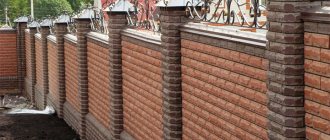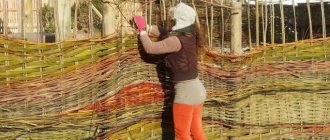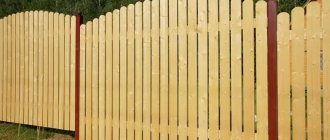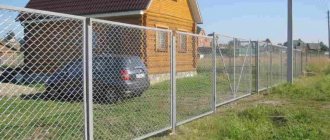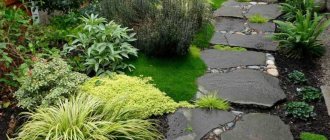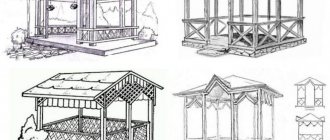Review author: Terrari School of Design
Brick fences are highly valued among residents of private houses. They are durable, practical and do not require special care. A high-quality brick fence built around the perimeter of the territory is a wonderful decoration of the site.
This is evidenced by numerous photos of a brick fence on the Internet. But before creating it, it is necessary to take into account many factors so that the fence is not only beautiful, but also durable.
Modern brick fences
For the construction of fences, clinker and sand-lime bricks are usually used. They, unlike ordinary ceramic bricks, do not need finishing (plastering or tiling).
However, the wall should be well connected with approximately 10mm joints. These types of bricks come in a variety of colors and textures.
Pillars built from these bricks (sometimes this also applies to brick fences with corrugated sheets) should be strengthened from the inside and filled with concrete (after all, the handles of spans and gates are attached to them).
Clinker brick does not require impregnation, since its water absorption is very low. On the other hand, silicate (especially split silicate) gets dirty easily, so it must be protected with a water-repellent agent.
Facade bricks – These used to be mostly red blocks, but are now produced in shades of white, yellow, brown or grey. You can easily choose the appropriate seam color or brick texture - corrugated or hand-molded. You can build a solid fence from bricks, but most often they are used to create foundations or pillars - it is important that they are reinforced.
Concrete block pillars can have different sizes, depending on the size of the bricks.
Brick fences must match the facade of the building and the surroundings of the site. Ideally, such a fence should be placed on a foundation at a height of 10-15 cm from the ground. Between the fence and the brick part it is necessary to put horizontal insulation (for example, made of foil) to prevent water from getting into the ground.
Every 10 m it is necessary to make expansion joints (the gap between the foundation and the span) so that the fence does not crack. In turn, the top of the fence with brick pillars, walls and base should be covered with a roof that protects from water.
The results of successful and erroneous decisions - a selection of photos
A beautiful design move would be to install lamps on the top of the columns. This can be either a design decision or a practical one.
Stylish decoration of a brick pillar with a cap and lamp
Artistic forging in the core of such a fence will not only look stylish, but will also show the taste of its owner.
Forged elements can be of completely different shapes and sizes
You can also decorate the top of the columns and along the entire perimeter of the fence with forged tips - this is beautiful, and can serve as a security system against criminals who can climb over the fence.
The combination of brick pillars and wooden sections looks no less attractive
Clinker fences
A brick fence can be finished with clinker tiles, which are slightly thinner than brick tiles (6-21 mm). Clinker posts after laying look like brick fence masonry, but their design is slightly different.
Like bricks, clinker fence designs can be created in a variety of colors - beige, red or brown.
The tiles should be glued to a frost-resistant clinker adhesive solution. After about 4 days, gaps will become noticeable between them - they need to be filled with grout.
Common methods of processing and protecting seams
The masonry of a finished brick pillar will look more beautiful if the seams are treated as follows.
- Rectangular undercut. It consists of removing excess mortar with a trowel and treating with a stiff brush or lint.
- Rectangular recessed. It consists of removing part of the mortar from the seam (5-6 mm) and compacting and smoothing it with a round dowel. The use of such treatment protects the masonry from natural manifestations.
- Beveled jointing. Used in harsh climates. Using a sharpened trowel at an acute angle, cut the mortar to a depth of 3-4 mm.
Clinker fences - advantages and disadvantages
The abundance of clinker fences proves only one thing - this is a truly universal and very good solution. Indeed, clinker fences are very popular.
Often such brick fences are made by hand. It is not surprising, because they are easy to keep clean and do not become overgrown with algae. Clinker fences are made from the same material as ceramic tiles, so they are durable and resistant to external influences.
Fences made of clinker bricks are not subject to darkening and growth of greenery. Their surface remains beautifully painted, and they are also quite resistant to mechanical damage.
Clinker tolerates frost and rain well. In addition, it comes in many shades, so you can match it to almost any building.
However, clinker fences are not without their drawbacks. Despite the fact that they are beautiful and durable, many people refuse them because of the price.
The cost of a clinker brick fence is higher than a simple brick fence. Clinker is relatively expensive, and the construction of the fence itself takes a lot of time.
Pauses during drying of the mortar must be maintained, and setting of the masonry takes a lot of time, which can significantly increase labor costs. In addition, this type of fence requires a foundation.
Materials for masonry
In order for the fence to look beautiful and the supports to be strong and reliable, it is necessary to use high-quality materials.
Brick selection
The bricks used for laying pillars vary not only in grade and workmanship, but also in appearance. So which brick to choose for fence posts? It can be an ordinary clay stone with smooth ends and internal voids to lighten the weight. It is affordable for most developers and has an attractive appearance.
Decorative products with a textured end surface look more original. In addition, such bricks are characterized by higher strength, durability and high resistance to environmental influences.
However, such material costs much more. Therefore, you can often see options for the combined use of ordinary clay bricks and decorative textured stones, which are placed every 2-3 rows or in another order.
Preparation of the solution
The optimal ratio of M400 cement and sand for preparing masonry mortar is 1:5. An increase in the amount of cement will lead to an unreasonable increase in the cost of purchasing materials, and a decrease will reduce the strength of the building structure.
To improve plasticity, you can buy a plasticizer or add liquid soap at the rate of 25 grams per bucket of solution. Adding soot will allow you to obtain a black mixture, which will look more original in the masonry.
The quality of the masonry depends on the thickness of the prepared cement-sand mixture. The solution should not be too liquid, but it should not be too dry either. When preparing the solution, water must be added gradually until the mixture of the required thickness is obtained.
Table of solution proportions.
To check, place a small amount of the prepared solution on a flat sheet and make a not very deep cross cut on top. Then shake the sheet slightly. For a good mixture, the cut lines should converge, and the solution itself should not spread across the surface.
Foundation for a clinker fence
Laying a clinker fence should begin with laying a foundation for a brick fence. Its type and size depends on many factors. First of all, the type of soil is important, secondly, the region of the country, and thirdly, the size and weight of the fence.
On sandy soil, the foundation for the fence can be only 60 cm deep. But already on planting soils, you need to make the foundation for the fence below the freezing zone of the ground, that is, to a depth of 80-140 cm.
The foundation does not need to be reinforced, but it is worth doing if the fence is heavy. In this case, the reinforcement can simply make the fence more stable. For clinker brick fencing, special concrete is used. It needs to dry for 7 days. During this time, it must be moistened regularly to prevent cracking.
Determining the type of structure
They begin work by carefully drawing up a drawing. The diagram should show:
- soil type;
- type, height of the foundation;
- height of pillars;
- location, area of the fence on the site;
- dimensions of gates, wickets;
- step between supports;
- material for filling openings;
- communications that can pass under the fence.
Scheme of a fence with red brick pillars
It is important to correctly calculate the load on the base so that the fence can withstand the weight of the materials and does not begin to collapse.
In addition, it is worth remembering the SNiP requirements for fences. You will find detailed recommendations of the current legislation in the article: “What distance should be from the house to the neighbors’ fence.”
Fence made of natural stone
They are similar in strength to metal fences, but do not lose their special appeal. Often the creation of foundations and pillars is made of sandstone or limestone, as well as granite. The structure is attached in the same way as clinker tiles, but the stone will require a special solution.
Walls are most often erected from hewn and split blocks (that is, of the correct shape) according to the principle of gluing masonry and using cement or cement-lime mortar (similar to brick).
A good imitation of stone are special blocks for the construction of fences - silicate and concrete blocks, which have many colors and textures. Their assembly is easy and quick.
It is also worth remembering about impregnation. Natural stone or hand-molded brick can also be imitated with concrete tile cladding.
You can easily stick it on regular (or elastic) mortar, and after 3 days you will be able to fill the gaps with mortar.
As for plastering, the cheapest is considered to be cement plaster, or cement-lime plaster painted with paint (preferably silicone, which reduces the penetration of water into the brick fence). This plaster has a huge advantage - it can be adjusted to the facade.

